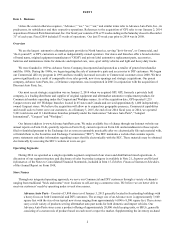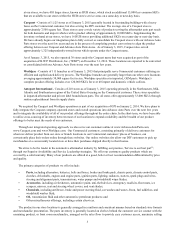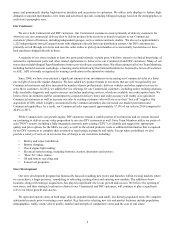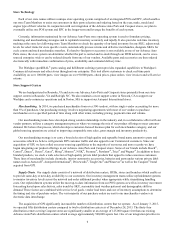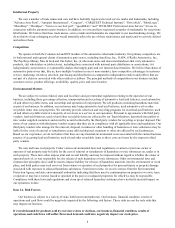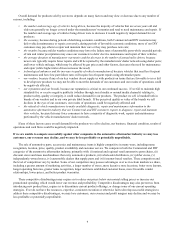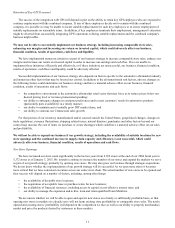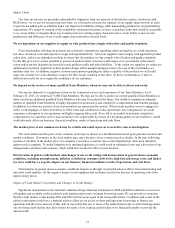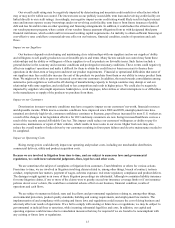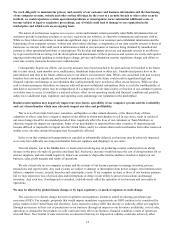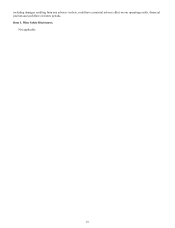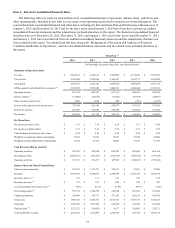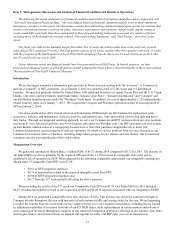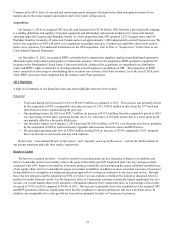Advance Auto Parts 2014 Annual Report Download - page 19
Download and view the complete annual report
Please find page 19 of the 2014 Advance Auto Parts annual report below. You can navigate through the pages in the report by either clicking on the pages listed below, or by using the keyword search tool below to find specific information within the annual report.12
Supply Chain
Our store inventories are primarily replenished by shipments from our network of distribution centers, warehouses and
HUB stores. As we service our growing store base, we will need to increase the capacity of our supply chain network in order
to provide the added parts availability under our Superior Availability strategy while maintaining productivity and profitability
expectations. We cannot be assured of the availability of potential locations on lease or purchase terms that would be acceptable
to us, of our ability to integrate those new locations into our existing supply chain network or of our ability to increase the
productivity and efficiency of our overall supply chain network to desired levels.
We are dependent on our suppliers to supply us with products that comply with safety and quality standards.
If our merchandise offerings do not meet our customers’ expectations regarding safety and quality, we could experience
lost sales, increased costs and exposure to legal and reputational risk. All of our suppliers must comply with applicable product
safety laws, and we are dependent on them to ensure that the products we buy comply with all safety and quality standards.
Events that give rise to actual, potential or perceived product safety concerns could expose us to government enforcement
action and/or private litigation and result in costly product recalls and other liabilities. To the extent our suppliers are subject to
additional government regulation of their product design and/or manufacturing processes, the cost of the merchandise we
purchase may rise. In addition, negative customer perceptions regarding the safety or quality of the products we sell could
cause our customers to seek alternative sources for their needs, resulting in lost sales. In those circumstances, it may be
difficult and costly for us to regain the confidence of our customers.
We depend on the services of many qualified Team Members, whom we may not be able to attract and retain.
Our success depends to a significant extent on the continued services and experience of our Team Members. As of
February 26, 2015, we employed 73,000 Team Members. We may not be able to retain our current qualified Team Members or
attract and retain additional qualified Team Members who may be needed in the future. Our ability to maintain an adequate
number of qualified Team Members is highly dependent on an attractive and competitive compensation and benefits package.
In addition, less than one percent of our team members are represented by unions. If these team members were to engage in a
strike, work stoppage, or other slowdown, or if the terms and conditions in labor agreements were renegotiated, we could
experience a disruption in our operations and higher ongoing labor costs. If we fail or are unable to maintain competitive
compensation, our customer service and execution levels could suffer by reason of a declining quality of our workforce, which
could adversely affect our business, financial condition, results of operations and cash flows.
The market price of our common stock may be volatile and could expose us to securities class action litigation.
The stock market and the price of our common stock may be subject to wide fluctuations based upon general economic and
market conditions. Downturns in the stock market may cause the price of our common stock to decline. In the past, following
periods of volatility in the market price of a company’s securities, securities class action litigation has often been instituted
against such a company. If similar litigation were instituted against us, it could result in substantial costs and a diversion of our
management’s attention and resources, which could have an adverse effect on our business.
Deterioration in global credit markets and changes in our credit ratings and deterioration in general macro-economic
conditions, including unemployment, inflation or deflation, consumer debt levels, high fuel and energy costs, and higher
tax rates could have a negative impact on our business, financial condition, results of operations and cash flows.
Deterioration in general macro-economic conditions impacts us through (i) potential adverse effects from deteriorating and
uncertain credit markets, (ii) the negative impact on our suppliers and customers and (iii) an increase in operating costs from
higher energy prices.
Impact of Credit Market Uncertainty and Changes in Credit Ratings
Significant deterioration in the financial condition of large financial institutions in 2008 and 2009 resulted in a severe loss
of liquidity and available credit in global credit markets and in more stringent borrowing terms. We can provide no assurance
that the credit market events during 2008 and 2009 will not occur again in the foreseeable future. Conditions and events in the
global credit market could have a material adverse effect on our access to short and long-term borrowings to finance our
operations and the terms and cost of that debt. It is possible that one or more of the banks that provide us with financing under
our revolving credit facility may fail to honor the terms of our existing credit facility or be financially unable to provide the
unused credit.


